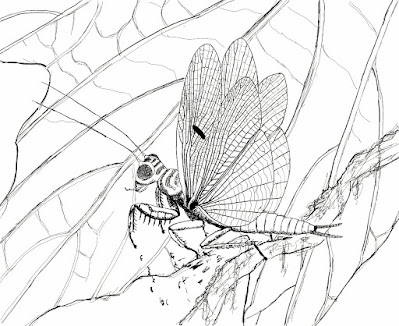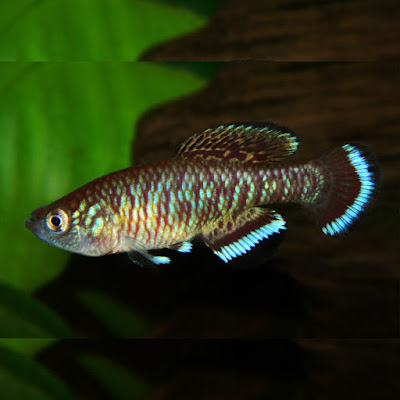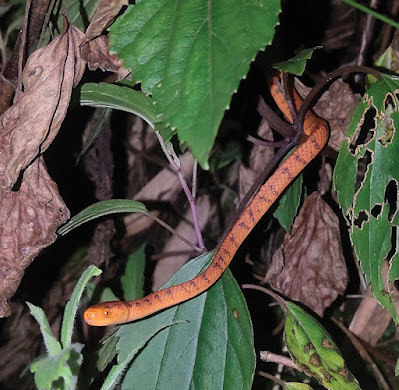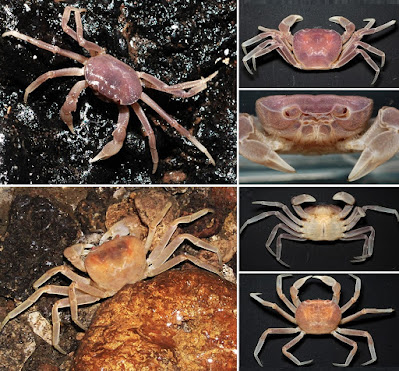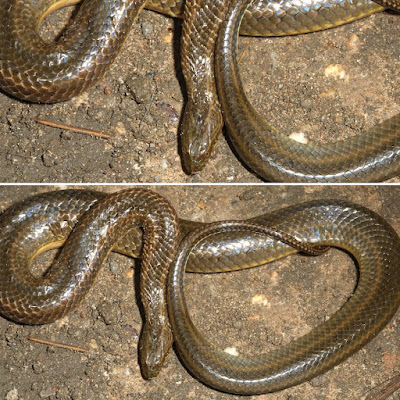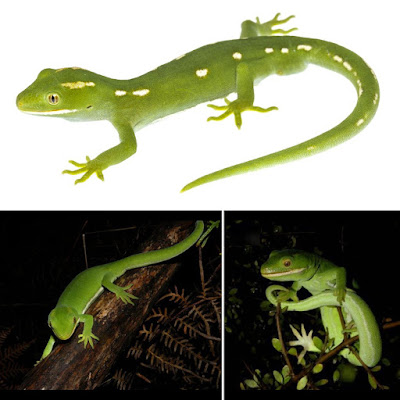[Most Recent Entries] [Calendar View]
Saturday, January 23rd, 2021
| Time | Event | ||||
| 6:15a | [PaleoEntomology • 2021] Labradormantis guilbaulti • Wing Morphology of A New Cretaceous Praying Mantis solves the Phylogenetic Jigsaw of Early‐diverging Extant Lineages
Abstract The extremely derived morphology and behaviour of extant praying mantises combined with a scarce record of fossil relatives introduce significant challenges to tracing their evolution from Palaeozoic stem‐dictyopterans. Extant members of Chaeteessidae, Mantoididae and Metallyticidae could be invaluable to resolving the mantodean tree, yet their inclusion in phylogenetic analyses led to conflicting hypotheses due to their highly disparate respective morphologies. In this contribution, we present Labradormantis guilbaulti gen. et sp.n., a new fossil species described from both fore‐ and hind‐wing imprints discovered in the Redmond Mine locality (Late Cretaceous, Cenomanian, Redmond Formation; Labrador, Canada). The examination of its hind‐wing AA2* supports the hypothesis that this structure, unique to Chaeteessidae among extant mantises, is a true vein and that its occurrence represents a plesiomorphy for Mantodea. A parsimony analysis including newly coded wing‐related characters further established that L. guilbaulti gen. et sp.n. displays a unique combination of plesiomorphic and apomorphic character states that situates it within the extinct family Baissomantidae. This dataset resolved the phylogenetic relationships of early‐diverging extant lineages as (Chaeteessidae (Mantoididae (Metallyticidae, Artimantodea))), and suggested that the Eocene Lithophotina floccosa Cockerell might be a close relative of extant metallyticids. It also indicated a trend towards increased modularity within mantis fore‐wings, in contrast with a trend towards increased morphological integration in their hind‐wings, both of which are potentially associated with improved flight performance for modern mantises. This study emphasizes the importance of fossils for resolving phylogenetic relationships and for introducing transitional phenotypes to infer ancient evolutionary trends of extant derived clades. Order Mantodea Burmeister, 1838 Family Baissomantidae Gratshev & Zherikhin, 1993 Composition. The family includes the genera Baissomantis (including Baissomantis picta Gratshev & Zherikhin, 1993 and Baissomantis maculata Gratshev & Zherikhin, 1993; see original descriptions and Grimaldi, 2003) and Labradormantis gen.n. Genus †Labradormantis gen.n. Type species. †Labradormantis guilbaulti sp.n., designated here. Etymology. Derived from the continental region of the Canadian province of Newfoundland‐and‐Labrador, where the Redmond no.1 Mine is located. †Labradormantis guilbaulti sp.n. Material. Holotype, MPEP1157.6, consisting in two incomplete fore‐wings, each with their clavus lost, along with two fragmentary legs. Paratype, MPEP702.11 (part and counterpart), consisting in two almost complete hind‐wings, the almost complete clavus of a fore‐wing, the metathorax and isolated leg segments. Clavus more complete in the part; metathorax more complete in the counterpart. Etymology. The specific epithet refers to Jean‐Pierre Guilbault, co‐founder of the MPE, in honour of his contribution to the MPE's first expedition to the Redmond Mine and of his ongoing contributions to the advancement of this museum. Locality and horizon. Redmond no.1 Mine located at coordinates 54°41′N and 66°45′W, Newfoundland‐and‐Labrador, Canada, 16 km south southeast of Schefferville; Redmond Formation, Late Cretaceous, Cenomanian (93.9–100.5 Ma). Diagnosis. In fore‐wing, stigma ellipsoidal, slightly curved (as opposed to a forming a strap‐shaped patch, as in Baissomantis). In hind‐wing, intercalary vein in the RP–M area arising basad of the first fork of RA (as opposed to arising apicad of the first fork of RA, as in Baissomantis). Alexandre V. Demers‐Potvin, Hans C.E. Larsson, Mario Cournoyer and Olivier Béthoux. 2021. Wing Morphology of A New Cretaceous Praying Mantis solves the Phylogenetic Jigsaw of Early‐diverging Extant Lineages. Systematic Entomology. 46(1); 205-223. DOI: 10.1111/syen.12457 | ||||
| 6:26a | [Ichthyology • 2021] Nothobranchius elucens • A New Species of Seasonal Killifish (Cyprinodontiformes: Nothobranchiidae) from the upper Nile drainage in Uganda Abstract Nothobranchius elucens, new species, from a seasonal habitat in the Aringa system of the Achwa River in the upper Nile drainage in northern Uganda, is described. It belongs to the N. rubroreticulatus species group, whose members are characterised by male coloration of anal and caudal fins with slender light blue subdistal band and slender dark distal band. Nothobranchius elucens is distinguished from all other members of the genus by the following characters in males: body colouration golden-grey with brown scale margins creating irregular vertical stripes on trunk; anal fin yellow with brown spots proximally, with slender brown median band, followed by a slender light blue subdistal band and a slender black distal band; caudal fin brown proximally and medially, followed by a slender light blue subdistal band and a slender black distal band; dorsal fin golden with irregular brown stripes and narrow light blue subdistal band and with narrow black distal band. Furthermore, it differs from the closest known relative, N. taiti, also by the morphometric characters of having a smaller head length of 29.5–33.1 % SL; smaller prepectoral length of 31.2–33.9 % SL; greater head depth of 81–87 % HL; greater interorbital width of 43–49 % HL; and greater caudal peduncle length of 145–152 in % of its depth. Keywords: Pisces, Achwa River drainage, Madi Opei area, upper Nile ecoregion Nothobranchius elucens, new species Béla Nagy. 2021. Nothobranchius elucens, A New Species of Seasonal Killifish from the upper Nile drainage in Uganda (Cyprinodontiformes: Nothobranchiidae). Zootaxa. 4915(1); 133–147. DOI: 10.11646/zootaxa.4915.1.10 | ||||
| 6:45a | [Herpetology • 2021] Pareas xuelinensis • A New Species of the Genus Pareas (Squamata, Pareidae) from Yunnan, China
Abstract A new species of Pareas is described from Yunnan Province, China, based on morphological comparisons and molecular data. Genetically, the new species is most closely related to the recently-described Pareas geminatus, for which we present new topotypic findings. The genetic divergence (uncorrected p-distance) of the cytb gene between the new species and congeners ranged from 6.14% to 24.68%. Morphologically, the new species can be distinguished from P. geminatus and all other congeners. Our work brings the total number of species within the genus Pareas to 22. Keywords: Molecular, morphological, snail-eating snake, taxonomy Pareas xuelinensis sp. nov. Diagnosis: Single preocular; postocular fused with subocular; loreal not bordering orbit; prefrontal bordering orbit; fourth or fifth infralabial fused with second chin-shield; three chin-shield pairs; dorsal scales in 15 rows throughout; vertebral scales not enlarged; scales not keeled at the anterior part of the body, three rows of mid-dorsal scales keeled at the middle of the body, five rows of mid-dorsal scales keeled at the posterior of body; seven supralabials; seven or eight infralabials; cloaca undivided; ventral scales 182–188; subcaudals 87–93, paired. Etymology: The specific epithet xuelinensis refers to Xuelin Township, the type locality of the new species. Distribution: This species is currently known only from the type locality Xuelin Township, Lancang County, Pu’er City, Yunnan Province, China. It is expected to be found in Myanmar.
Habitat: Both the holotype and paratypes were found on the bushes beside a small road at night, surrounded by forest and farmland, with no river or stream nearby. Shuo Liu and Dingqi Rao. 2021. A New Species of the Genus Pareas (Squamata, Pareidae) from Yunnan, China. ZooKeys. 1011: 121-138. DOI: 10.3897/zookeys.1011.59029 | ||||
| 7:29a | [Crustacea • 2021] Arachnothelphusa sarang • A New Species of the Genus Arachnothelphusa Ng, 1991 (Decapoda: Gecarcinucidae) from A Limestone Cave in Sarawak (Malaysian Borneo)
Abstract A new species of cavernicolous gecarcinucid crab, Arachnothelphusa sarang, is described from a limestone cave in northern Sarawak, Malaysian Borneo. This increases the number of Arachnothelphusa species to six. It is the second member in the genus that is known to primarily occupy limestone caves, the other being A. rhadamanthysi Ng & Goh, 1987, from Gomantong in Sabah. Both species appear to be cavernicolous species with pale body colouration in life. Key words: Brachyura, taxonomy, Oriental region, freshwater crab, cavernicolous crab TAXONOMY Family Gecarcinucidae Rathbun, 1904 Arachnothelphusa Ng, 1991 Type species. Potamon (Potamon) melanippe De Man, 1899, by original designation. Arachnothelphusa sarang, new species Diagnosis. Carapace surface convex, rugose, finely granular; anterolateral margins convex, serrated; antero- and posterolateral regions prominently rugose, covered with numerous coarse granules; epibranchial tooth very low or indistinct; external orbital tooth very low, broadly triangular, outer margin slightly concave, distinctly serrated; epigastric and postorbital cristae distinct; cervical and H-grooves deep, not confluent (Fig. 2A, C); ambulatory legs long, merus of fourth ambulatory legs subequal to length of carapace (Fig. 2A, B, E); carpus of chelipeds rugose, with fine granules, inner angle with broadly triangular tooth (Fig. 2A, D); chela relatively short, fingers as long as palm, cutting teeth on pollex not prominent (Fig. 2D). Male pleon T-shaped, somite 6 subequal to length of telson (Fig. 2B). G1 slender, sinuous, gently curving outwards; terminal segment cylindrical, tapering, about one third length of subterminal segment (Fig. 3A–D). G2 with short distal segment, less than a quarter length of basal segment (Fig. 3E). Etymology. The species is named after the locality where the holotype was collected. The name is used as a noun in apposition. Jongkar Grinang and Peter K. L. Ng. 2021. A New Species of the Genus Arachnothelphusa Ng, 1991 (Crustacea: Decapoda: Gecarcinucidae) from A Limestone Cave in Sarawak (Malaysian Borneo). Raffles Bulletin of Zoology. 69; 1–7. | ||||
| 7:46a | [Herpetology • 2021] Myanophis thanlyinensis • A New Genus and Species of Mud Snake (Serpentes, Homalopsidae) from Myanmar
Abstract Based on two male and two female individuals, we describe a new genus and species of mud snake, Myanophis thanlyinensis gen. nov., sp. nov., from the vicinity of the campus of East Yangon University, Yangon, Thanlyin, Myanmar. This species differs from every other homalopsid species by the following combination of characters: (1) dorsal scales smooth, row formula 21–21–19 or 21–21–17; (2) tail short, ratio tail length/SVL 0.185–0.204 in males, 0.160–0.167 in females; (3) nasal scales separated; (4) 125–126 ventral scales in males, 120–122 in females; (5) 38–39 subcaudal scales in males, 32–34 in females; and (6) hemipenis bilobed. Its matrilineal genealogy (based on analyses of 16S and cytochrome b sequences), associates Myanophis thanlyinensis gen. nov., sp. nov. most closely with species of the genera Myrrophis and Gyiophis. The new taxon differs from the species of Myrrophis and Gyiophis by having a bilobed hemipenis (vs. unilobed). Myanophis thanlyinensis gen. nov., sp. nov. differs further from the species of Myrrophis by having 125–126 ventral scales in males and 120–122 in females (vs. 137–162 and 137–164, respectively), and 38–39 subcaudal scales in males and 32–34 in females (vs. 39–55 and 37–52, respectively). Myanophis thanlyinensis gen. nov., sp. nov. differs further from the species of Gyiophis by lacking dark blotches along flank (vs. present), and by having 21 dorsal scales rows at midbody (vs. 25). We provide an identification key to the homalopsid species known to occur in Myanmar. As a novelty to the classic holotype description and characterization, the individual has been genome sequenced by Illumina short-read technology and its genome has been assembled into a draft nuclear genome and a complete, annotated mitochondrial genome. This innovative approach comprehensively and permanently characterizes the genomic variation of the holotype. Keywords: Reptilia, Cryptic diversity, DNA barcoding; genome, Myanophis thanlyinensis gen. nov. sp. nov. Gunther Köhler, Khin Pa Pa Khaing, Ni Lar Than, Damian Baranski, Tilman Schell, Carola Greve, Axel Janke and Steffen U. Pauls. 2021. A New Genus and Species of Mud Snake from Myanmar (Reptilia, Squamata, Homalopsidae). Zootaxa. 4915(3); 301–325. DOI: 10.11646/zootaxa.4915.3.1 | ||||
| 9:52a | [Herpetology • 2021] Naultinus flavirictus • A New Species of Naultinus (Gekkota: Diplodactylidae) from the Te Paki Area, northern New Zealand
Abstract We describe a new species of the New Zealand diplodactylid gecko genus Naultinus. Molecular phylogenetics and distinctive morphological features support taxonomic separation of the populations on the northern half of Aupori Peninsula in the far north of the North Island as a new species, Naultinus flavirictus sp. nov. The specific epithet refers to the diagnostic yellow colour at the corners of the mouth. We discuss the conservation status of and threats to this novel taxon and to Te Paki, Northland—the unique area of New Zealand where it is found. We further discuss the distribution and possible function of bright mouth colour within Naultinus. Keywords: Reptilia, New Zealand, gecko, Diplodactylidae, taxonomy, new species, Naultinus flavirictus sp. nov. Rodney A. Hitchmough, Stuart V. Nielsen, Judith A. Lysaght and Aaron M. Bauer. 2021. A New Species of Naultinus from the Te Paki Area, northern New Zealand. Zootaxa. 4915(3); 389–400. DOI: 10.11646/zootaxa.4915.3.7 |
| << Previous Day |
2021/01/23 [Calendar] |
Next Day >> |
